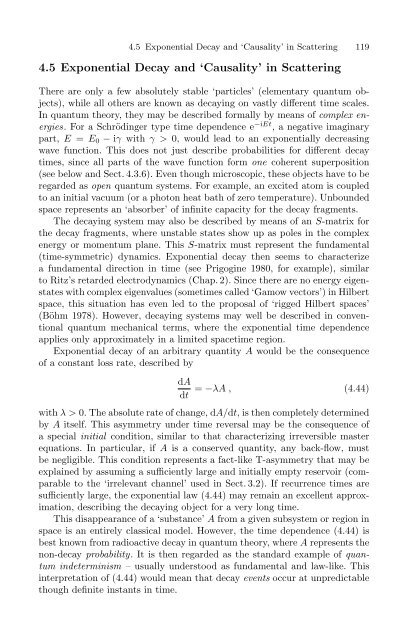The Physical Basis of The Direction of Time (The Frontiers ...
The Physical Basis of The Direction of Time (The Frontiers ...
The Physical Basis of The Direction of Time (The Frontiers ...
You also want an ePaper? Increase the reach of your titles
YUMPU automatically turns print PDFs into web optimized ePapers that Google loves.
4.5 Exponential Decay and ‘Causality’ in Scattering 119<br />
4.5 Exponential Decay and ‘Causality’ in Scattering<br />
<strong>The</strong>re are only a few absolutely stable ‘particles’ (elementary quantum objects),<br />
while all others are known as decaying on vastly different time scales.<br />
In quantum theory, they may be described formally by means <strong>of</strong> complex energies.<br />
ForaSchrödinger type time dependence e −iEt , a negative imaginary<br />
part, E = E 0 − iγ with γ > 0, would lead to an exponentially decreasing<br />
wave function. This does not just describe probabilities for different decay<br />
times, since all parts <strong>of</strong> the wave function form one coherent superposition<br />
(see below and Sect. 4.3.6). Even though microscopic, these objects have to be<br />
regarded as open quantum systems. For example, an excited atom is coupled<br />
to an initial vacuum (or a photon heat bath <strong>of</strong> zero temperature). Unbounded<br />
space represents an ‘absorber’ <strong>of</strong> infinite capacity for the decay fragments.<br />
<strong>The</strong> decaying system may also be described by means <strong>of</strong> an S-matrix for<br />
the decay fragments, where unstable states show up as poles in the complex<br />
energy or momentum plane. This S-matrix must represent the fundamental<br />
(time-symmetric) dynamics. Exponential decay then seems to characterize<br />
a fundamental direction in time (see Prigogine 1980, for example), similar<br />
to Ritz’s retarded electrodynamics (Chap. 2). Since there are no energy eigenstates<br />
with complex eigenvalues (sometimes called ‘Gamow vectors’) in Hilbert<br />
space, this situation has even led to the proposal <strong>of</strong> ‘rigged Hilbert spaces’<br />
(Böhm 1978). However, decaying systems may well be described in conventional<br />
quantum mechanical terms, where the exponential time dependence<br />
applies only approximately in a limited spacetime region.<br />
Exponential decay <strong>of</strong> an arbitrary quantity A would be the consequence<br />
<strong>of</strong> a constant loss rate, described by<br />
dA<br />
dt<br />
= −λA , (4.44)<br />
with λ>0. <strong>The</strong> absolute rate <strong>of</strong> change, dA/dt, is then completely determined<br />
by A itself. This asymmetry under time reversal may be the consequence <strong>of</strong><br />
a special initial condition, similar to that characterizing irreversible master<br />
equations. In particular, if A is a conserved quantity, any back-flow, must<br />
be negligible. This condition represents a fact-like T-asymmetry that may be<br />
explained by assuming a sufficiently large and initially empty reservoir (comparable<br />
to the ‘irrelevant channel’ used in Sect. 3.2). If recurrence times are<br />
sufficiently large, the exponential law (4.44) may remain an excellent approximation,<br />
describing the decaying object for a very long time.<br />
This disappearance <strong>of</strong> a ‘substance’ A from a given subsystem or region in<br />
space is an entirely classical model. However, the time dependence (4.44) is<br />
best known from radioactive decay in quantum theory, where A represents the<br />
non-decay probability. It is then regarded as the standard example <strong>of</strong> quantum<br />
indeterminism – usually understood as fundamental and law-like. This<br />
interpretation <strong>of</strong> (4.44) would mean that decay events occur at unpredictable<br />
though definite instants in time.



![arXiv:1001.0993v1 [hep-ph] 6 Jan 2010](https://img.yumpu.com/51282177/1/190x245/arxiv10010993v1-hep-ph-6-jan-2010.jpg?quality=85)


![arXiv:1008.3907v2 [astro-ph.CO] 1 Nov 2011](https://img.yumpu.com/48909562/1/190x245/arxiv10083907v2-astro-phco-1-nov-2011.jpg?quality=85)








![arXiv:1002.4928v1 [gr-qc] 26 Feb 2010](https://img.yumpu.com/41209516/1/190x245/arxiv10024928v1-gr-qc-26-feb-2010.jpg?quality=85)
![arXiv:1206.2653v1 [astro-ph.CO] 12 Jun 2012](https://img.yumpu.com/39510078/1/190x245/arxiv12062653v1-astro-phco-12-jun-2012.jpg?quality=85)
